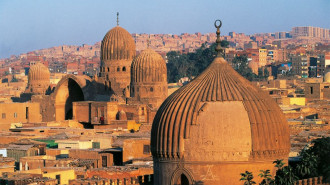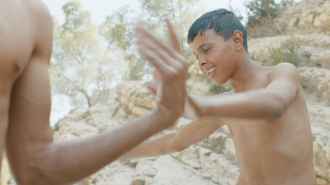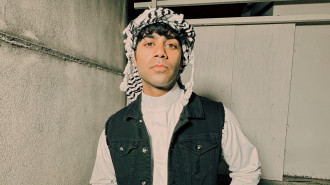
Technicolours in the desert: Qatar's public spaces become open cultural canvas ahead of World Cup

Qatar is busy gearing up for the 2022 FIFA World Cup in November, but it’s not all about football. Aiming to transform the country into an open-air art experience, Qatar Museums will be installing about 40 new public artworks around the country.
In the coming weeks, installations by international and local artists, such as Jeff Koons, Yayoi Kusama and Shouq Al Mana, will be placed publically for everyone to enjoy, from Doha’s Souq Waqif to the Qatari desert.
The project is part of Qatar Creates – the year-round cultural movement that promotes diverse cultural activities in Qatar – organised by Qatar Museums.
"It's important to continue to recreate aspects of our culture in a contemporary manner to maintain this identity and authenticity within communities, and enhance the sense of awareness for residents or visitors"
“These are not only dotted around the city centre but also expanding outside of the capital, for example to the Al Zubarah area on the west coast,” head of curatorial planning for public art Sarah Lawler told The New Arab. “We're really trying to activate areas that might not always have arts in, to reach a new audience and new demographics.
“I think public art is really all about dialogue and speaking to different members of the community. What's really interesting about the program is that it brings together so many different artists into one country,” she added.
“Once all the artworks are placed, we're going to have a public art map that is self-led, where you can find clusters of artworks in walking distance of each other. We will also have guided tours.”
Koon’s Dugong, a monumental 21 x 31-metre mirror-polished stainless-steel sculpture, is just one of the anticipated artworks. Modelled after the ancient marine mammal that inhabited the waters surrounding Qatar's peninsula for centuries, the piece will be on view at Al Masrah Park in Doha.
Lebanese artist Simone Fattal has created three blue granite sculptures in the Al Zubarah desert in the shape of tents, reflecting the history and nomadic heritage of the area.
It’s hoped the new artworks in less-travelled places will encourage people to visit and explore those areas, such as Spanish artist Richard Serra’s East-West/West-East, which has become a touristic attraction in the Zekreet desert.
“People come to Doha, but they always want to go to the desert to go see that artwork. So I think that's what we're trying to do,” Lawler said. “We're trying to bring people outside of the city as well, and allow people to venture out to other areas of Doha and other areas of Qatar, too.”
A committee of curators selects the artworks, as well as hosting an open call to encourage young emerging artists to take part. Amongst the 40 new installations are pieces by Qatari artists Shouq Al Mana and Shua'a Ali, who usually create work for gallery spaces. This is the first time they produce something of this scale.
“The open calls are really about giving local artists an opportunity to venture into public art,” Lawler said. “Public art is expensive, and it's not something that someone might necessarily be able to achieve alone. So we are there to really support the next generation of public art artists.”
Ali’s works Tawazun in Msheireb and Milestones in Grand Hamad Plaza draw inspiration from way-finders placed in deserts to guide travellers through the monotonous landscape. She aims to explore the relationship between the past and present-day Doha, using the stacking of materials to create perfectly balanced stone sculptures.
"I believe it's important to continue to recreate aspects of our culture in a contemporary manner to maintain this identity and authenticity within communities and enhance the sense of awareness for residents or visitors,” Ali told The New Arab. “My creative process starts by collecting construction debris locally, due to the busy construction surrounding our present daily experience.
“This phenomenon symbolizes progress and development. I place the elements in a visual-conceptual balancing and stacking composition to signify the equilibrium between past and present elements, such as old building material versus new,” she added. “The local environment and culture have always been an inspiration for my work. I'm inspired by location marks that are found in unpaved roads and desert areas mainly used for navigation and boundary markings.”
Although many visitors will be coming to Qatar primarily for the World Cup, Lawler hopes that public art will be a way for football fans to still experience their cultural offerings in a digestible, more passive way, than having to plan museum and gallery visits.
“The amazing thing about public art is you don't need a ticket for it or to make an effort to see it,” Lawler said. “It's there around the corner, on your way to work, on your way to the stadium; you're going to encounter public arts wherever you go. I think for a lot of people, even if they're not interested in actively wanting to see public arts will stop and look, maybe take a photo or go read the labels; interact with it or think about it."
Maghie Ghali is a British-Lebanese journalist based in Beirut. She worked for The Daily Star Lebanon and writes as a freelancer for several publications, including The National, Al Arabiya English, Al Jazeera and Middle East Eye, on arts and culture/design, environment and humanitarian topics.
Follow her on Twitter: @mghali6
![Simone Fattal's Gates to the Sea at the National Musuem of Qatar [Photo by Maghie Ghali]](/sites/default/files/styles/large_16_9/public/2022-10/Untitled_8.jpg?h=d1cb525d&itok=CgHpIO_7)
![Shua’a Ali's Milestones on Grand Hamad Street [Photo by Maghie Ghali]](/sites/default/files/styles/large_16_9/public/2022-10/Shua%E2%80%99a%20Ali%27s%20Milestones%20on%20Grand%20Hamad%20Street.%20Photo%20by%20Maghie%20Ghali.jpg?h=fb6a63f8&itok=pTm1KKtY)
![Rose III by Isa Genzken is an eight-meter-high sculpture of a rose in cast aluminium and galvanized steel in M7 [Photo by Maghie Ghali]](https://www.newarab.com/themes/custom/new_arab/images/DefaultImage.jpg)
![Palestinians mourned the victims of an Israeli strike on Deir al-Balah [Getty]](/sites/default/files/styles/image_684x385/public/2024-11/GettyImages-2182362043.jpg?h=199d8c1f&itok=xSHZFbmc)


![The law could be enforced against teachers without prior notice [Getty]](/sites/default/files/styles/image_684x385/public/2178740715.jpeg?h=a5f2f23a&itok=hnqrCS4x)
 Follow the Middle East's top stories in English at The New Arab on Google News
Follow the Middle East's top stories in English at The New Arab on Google News


